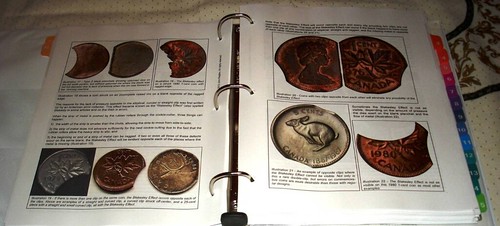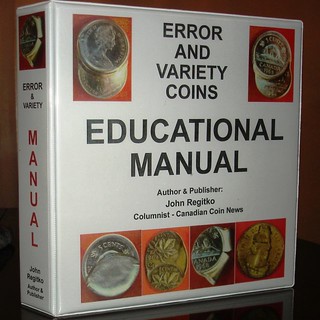
PREV ARTICLE
NEXT ARTICLE
FULL ISSUE
PREV FULL ISSUE
NEW BOOK: ERROR AND VARIETY EDUCATIONAL MANUAL
Canadian Coin News’ columnist John Regitko’s book on Canadian error and variety coins is available from Trajan Publishing.
-Editor
Die-related errors and varieties are next, followed by errors produced by the minting press, including set-up, feeding, striking and ejection. The “Tools” section includes write-ups on every conceivable item one might want to assist in examining, identifying and authenticating errors and varieties, including a listing of books and catalogues. Two whole sections dealing with the identification of genuine and phony errors are also well-illustrated, including the difficult types with missing metal. The “Terminology” chapter discusses terms that were used since errors and varieties came on the scene, including those used by Hans Zoell in his various publications. Out-of-favour, bad and simply wrong terms are brought to the readers’ attention in an attempt to prevent others from repeating information that has been proven incorrect. The chapter “Varieties you are not looking for” covers recently discovered errors and scarce varieties that are lurking out there, to be discovered by people who know what to look for. Errors found on $2 coins as well as on colourized circulating coins are covered in separate chapters. These include some types that you might not be aware of because some inexpensive tools are required to see them. Other topics are “Security at the Mint“ and “Backdoor Jobs from the Royal Canadian Mint.” This last section recaps some of the shenanigans that have taken place at the Mint in past years, such as the spectacular errors of Canadian coins that originated at the little known branch plant at Hull, PQ. The author also delves into his involvement in assisting the Mint in closing some “backdoors.” Errors from private mints, including the Badger Mint, Sherritt Mint and Lombardo Mint, include transportation tokens, municipal trade dollars, medals and other mediums of exchange that form part of numismatics, are illustrated. Numerous token errors of the Toronto Transportation Commission are shown. Transportation ticket errors and even error transfers are touched upon.

Students at the four seminars run by Regitko stated that they consider the manual alone worth the cost. However, there is considerable additional content. Five CDs containing videos relating to errors and varieties are included. One of the CD contains Regitko’s 43-minute presentation he gave at a Humber College seminar sponsored by the Royal Canadian Numismatic Association. It covers the creation of the strip, cutting out of blanks, adding the rim, and a step-by-step explanation of the minting process at the RCM, accompanied by images of the errors that occurred during each step, similar to the expanded presentation contained in chapters 1 and 2 of the manual. Two interesting videos included on the CDs are the production process at the Royal Canadian Mint in 1920 and at the U.S. Mint in 1940. Other videos also cover the more recent production process at the U.S. and Canadian Mints, and various videos from YouTube that bring out the good and the bad of the Internet, with presentations on wonderful errors and ridiculous claims and values. The total cost of the Manual, including the CDs, is $115. This includes packaging and postage to anywhere in Canada. Additional shipping cost for U.S. orders will be calculated at cost. Inventory is on hand for immediate ship-out or for pickup at the Trajan office in St. Catharines. Regitko states: “It took most of my life to accumulate the most complete typeset of Canadian error coins that anyone ever managed to gather. Although my column in CCN shared a lot of images and background over an eight-year period, the Error and Variety Educational Manual gave me the opportunity to showcase the colour images in one place. It also allowed me to publish the stories of their creation and background that would otherwise be lost to the rich history of Canadian numismatics.”
For more information, or to order, see:
The Numismatic Bibliomania Society is a non-profit organization promoting numismatic literature. See our web site at coinbooks.org. To submit items for publication in The E-Sylum, write to the Editor at this address: whomren@gmail.com To subscribe go to: https://my.binhost.com/lists/listinfo/esylum All Rights Reserved. NBS Home Page Contact the NBS webmaster 
|
